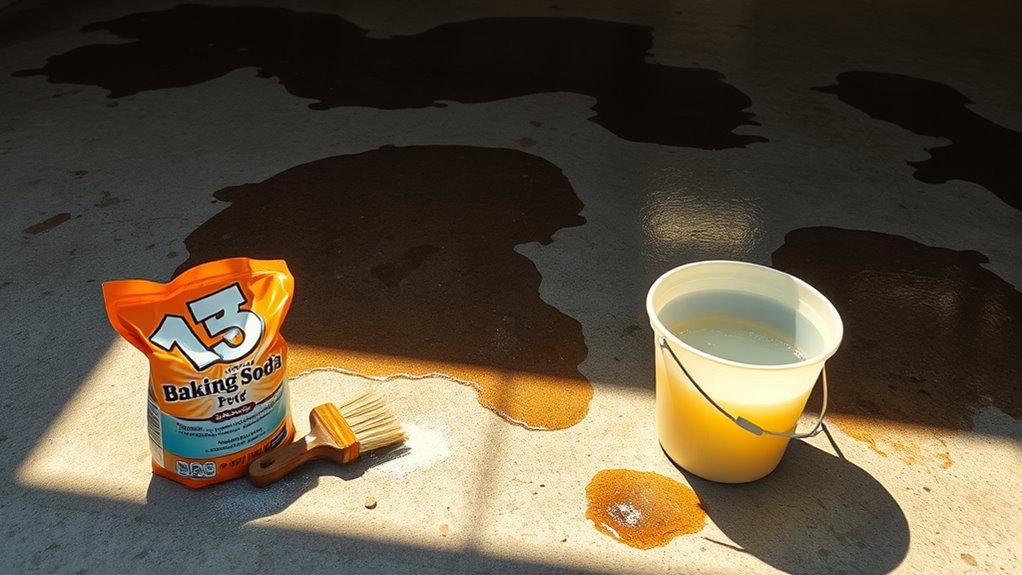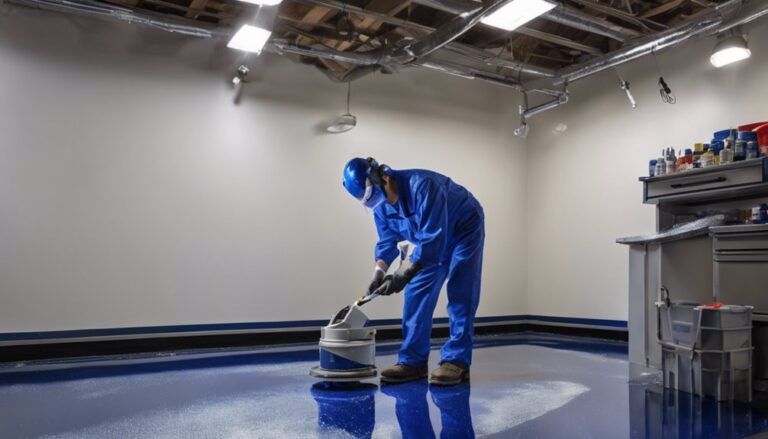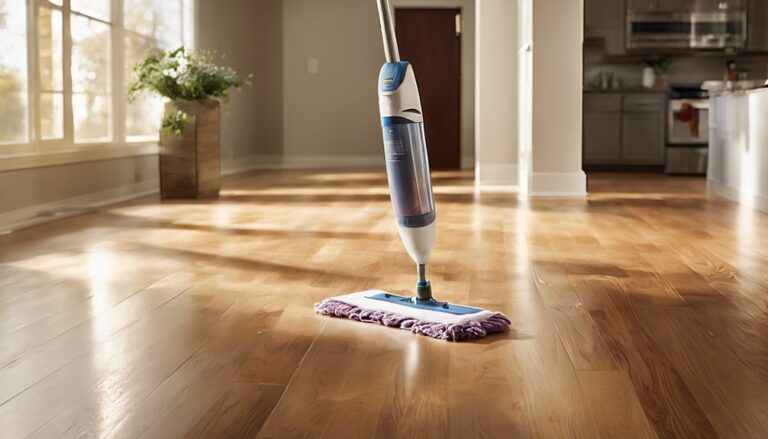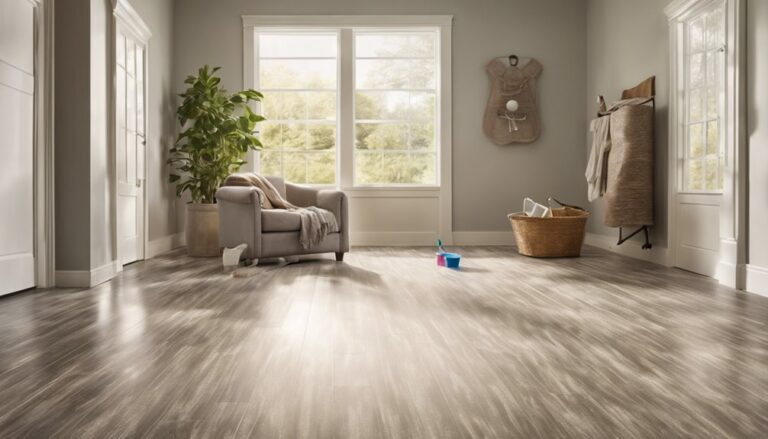To get oil off your garage floor, start by soaking up fresh spills with absorbent materials like kitty litter. Use a degreaser or a mix of dish soap and warm water, scrubbing the stain with a stiff brush. For older stains, try baking soda or vinegar-water solutions, then rinse thoroughly. Applying protective coatings and mats can help prevent future stains. Keep your supplies handy for quick cleanup—explore deeper strategies to maintain a spotless, durable garage floor.
Assessing the Oil Stain Severity
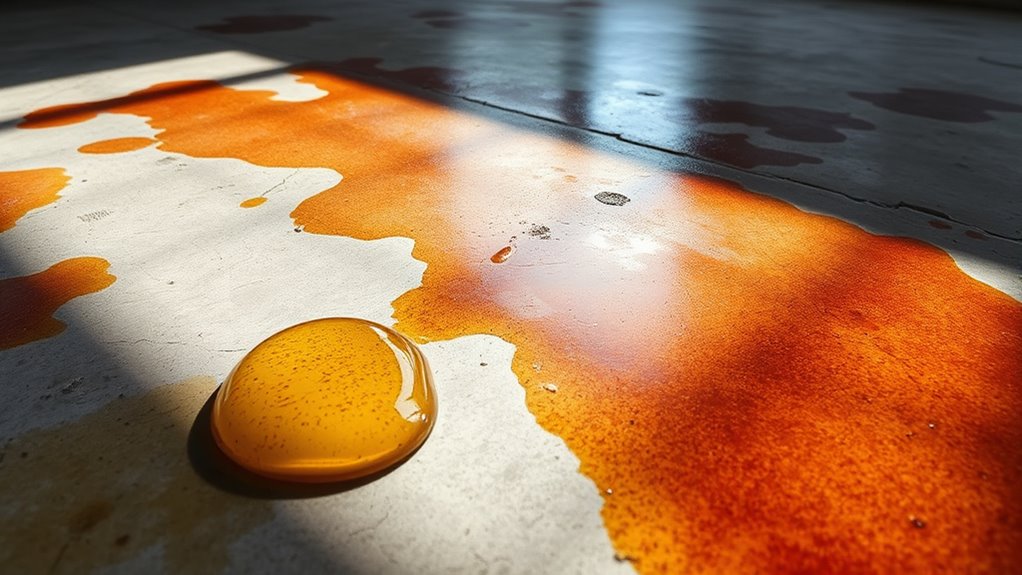
How deep is the oil stain on your garage floor? Begin with oil stain identification by closely examining the affected area. Look for discoloration intensity and size to gauge the stain’s penetration. A light, surface stain usually appears glossy or slightly darker than the concrete, signaling minimal absorption. Conversely, a deep, dark, and spreading stain suggests the oil has seeped into porous concrete, requiring more intensive treatment. Conduct a severity assessment by gently pressing a clean cloth on the stain—if oil transfers easily, the stain is fresh and surface-level. If the stain resists and appears ingrained, it’s more severe. This methodical evaluation helps you understand the stain’s depth and guides your cleaning approach, enabling you to regain control of your garage space efficiently.
Gathering Necessary Cleaning Supplies
Once you’ve determined the severity of the oil stain, the next step is to gather the right cleaning supplies to tackle it effectively. Having the proper cleaning tools on hand guarantees you work efficiently and boosts stain prevention.
Here’s a concise list to get you started:
- Absorbent materials – such as kitty litter or sawdust, to contain fresh spills quickly.
- Degreaser or heavy-duty cleaner – specifically designed for oil stains on concrete.
- Scrub brush with stiff bristles – to agitate and lift the oil from the surface without damaging your garage floor.
Collecting these supplies before you begin gives you freedom to act swiftly and prevents the stain from setting, making your cleaning effort more effective and less time-consuming.
Using Absorbent Materials to Soak Up Fresh Oil
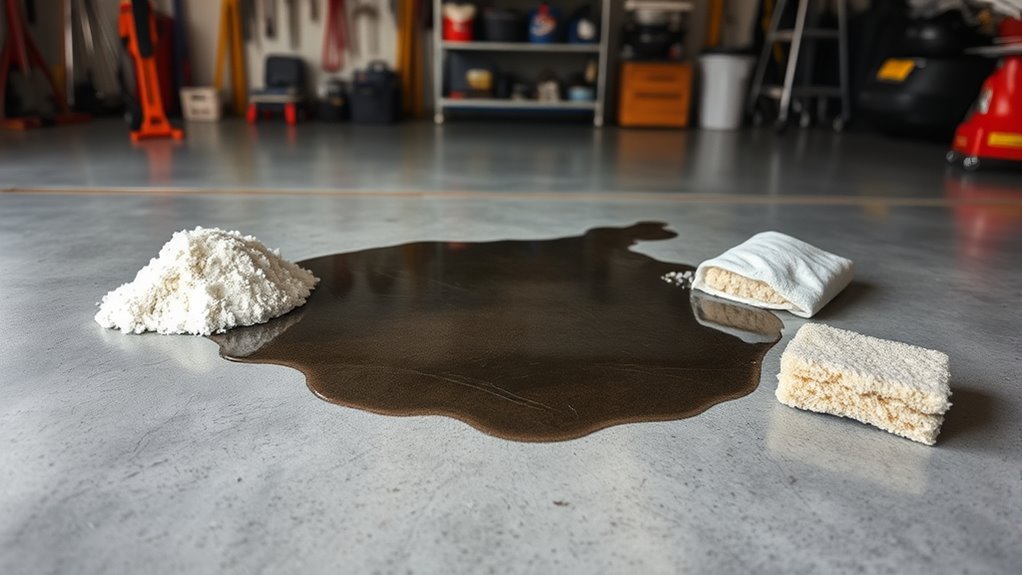
Three key steps will help you effectively use absorbent materials to soak up fresh oil spills on your garage floor. First, immediately cover the spill with a generous layer of oil absorbents, such as kitty litter, sawdust, or commercial clay-based products. This prevents the oil from spreading or soaking deeper into the concrete. Next, allow the absorbents to sit for at least 30 minutes to fully soak up the oil. Finally, sweep up the saturated material carefully, disposing of it according to local hazardous waste guidelines. Using absorbent materials promptly is essential for efficient oil cleanup and helps minimize stains. By following this methodical approach, you maintain control over the spill and avoid prolonged damage, preserving your garage floor’s condition and your freedom from lingering messes.
Applying Commercial Degreasers Effectively
To remove oil stains thoroughly, you’ll need to select a commercial degreaser suited for your garage floor’s surface. Apply the product evenly, following the instructions to allow adequate dwell time for breaking down the oil. Using the proper technique guarantees the degreaser penetrates the stain for effective cleaning.
Choosing the Right Degreaser
How do you determine which degreaser will work best on your garage floor? Start by understanding degreaser types and considering your priorities, including eco friendly options. Here’s how to choose wisely:
- Identify the stain severity: Heavy oil stains need industrial-strength degreasers, while lighter marks can be tackled with mild, biodegradable ones.
- Check surface compatibility: Confirm the degreaser suits concrete floors without causing damage or discoloration.
- Evaluate environmental impact: Opt for eco friendly options when possible to reduce harmful chemicals and protect your surroundings.
Proper Application Techniques
Once you’ve selected the appropriate degreaser for your garage floor, knowing how to apply it correctly will maximize its effectiveness. Start by sweeping the area to remove loose dirt. Then, generously spray or pour the commercial degreaser directly onto the oil-stained spots. Allow it to penetrate for 10 to 15 minutes, letting the cleaning agents break down the oil. Avoid letting it dry completely. Next, use a stiff brush or broom to agitate the area, enhancing oil removal. For stubborn stains, repeat the process or use a pressure washer if available. Finally, rinse thoroughly with water to wash away residue. Following these cleaning techniques guarantees you regain control over your space, freeing your garage floor from oil stains efficiently and effectively.
Homemade Cleaning Solutions for Oil Removal
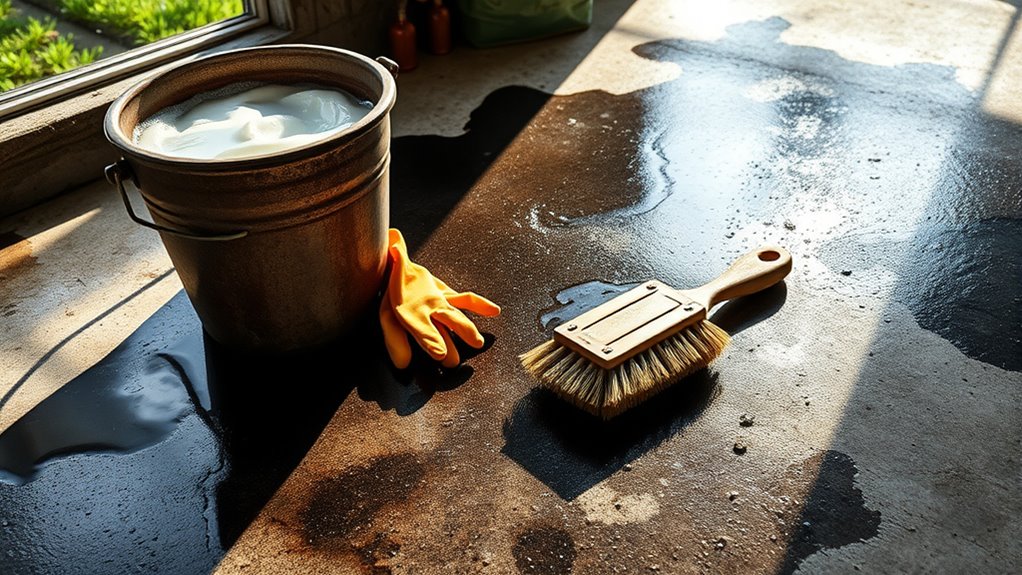
You can tackle oil stains using common household ingredients like baking soda, dish soap, and vinegar. Applying these solutions correctly involves scrubbing the area thoroughly and allowing time for the cleaner to break down the oil. Remember to wear gloves and guarantee proper ventilation to protect yourself during the process.
Common Household Ingredients
Although commercial cleaners are effective, common household ingredients can provide a simple and affordable way to remove oil stains from your garage floor. You don’t need specialized products to tackle those stubborn spots. Here are three key ingredients you can rely on:
- Baking Soda – Absorbs fresh oil spills and lifts dried stains by breaking down the grease.
- Vinegar Mixture – Mix equal parts vinegar and water to dissolve residual oil and neutralize odors.
- Dish Soap – Designed to cut through grease, it’s highly effective when combined with warm water for scrubbing.
Using these ingredients allows you to maintain control over your cleaning process without extra cost or chemicals. They’re readily available, eco-friendly, and empower you to restore your garage floor with ease.
Application Techniques
Start by applying your chosen homemade cleaning solution directly onto the oil stain, ensuring full coverage for maximum effectiveness. Use a brush or sponge to gently work the solution into the concrete, focusing on spot cleaning to target the affected area without spreading the stain. Let the solution sit for 15 to 30 minutes, allowing it to break down the oil residue. Next, scrub the stain firmly but carefully, then rinse with warm water. Repeat the process if necessary, as thorough application enhances stain prevention by removing oil before it settles. Dry the area completely to avoid re-soiling. By following these precise application techniques, you maintain control over the cleaning process, ensuring your garage floor stays clean and free from stubborn oil stains.
Safety Precautions
When handling homemade cleaning solutions for oil removal, it’s crucial to take specific safety precautions to protect yourself and your surroundings. You want to make certain the process is effective without risking harm.
- Always wear appropriate protective gear, including gloves and eye protection, to prevent skin irritation or accidental splashes.
- Maintain proper ventilation importance by working in a well-ventilated area or opening doors and windows to avoid inhaling fumes from your cleaning mixture.
- Store all ingredients and leftover solutions safely, out of reach of children and pets, to prevent accidental ingestion or spills.
Scrubbing Techniques for Stubborn Stains
If you’re dealing with stubborn oil stains on your garage floor, effective scrubbing techniques are vital to break down and lift the residue. Start by applying a degreaser or a specialized stain remover directly onto the affected area. Let it sit for 10–15 minutes to penetrate the oil. Use a stiff-bristled brush to agitate the stain; circular scrubbing methods work best to loosen the particles trapped in the concrete pores. Avoid using wire brushes that may damage the surface. For better stain removal, you can scrub in multiple directions to reach all angles of the stain. After scrubbing, rinse thoroughly with water and repeat the process if necessary. This methodical approach guarantees you regain control over your garage floor’s cleanliness without extensive effort.
Utilizing Pressure Washers Safely
Although pressure washers can be highly effective at removing oil stains from your garage floor, you’ll need to use them carefully to avoid damaging the concrete surface. Mastering pressure washer safety guarantees you get results without costly repairs. Here are essential pressure washer tips to follow:
- Start with a low-pressure setting and gradually increase it. High pressure can etch or crack concrete.
- Keep the nozzle at least 12 inches from the floor, moving it evenly to prevent uneven cleaning and surface damage.
- Wear protective gear—gloves, goggles, and sturdy shoes—to protect yourself from debris and high-pressure water.
Preventative Measures to Avoid Future Stains
After effectively cleaning your garage floor with a pressure washer, taking steps to prevent future oil stains can save you time and effort. Start by applying oil resistant coatings to your concrete surface; these create a protective barrier that repels oil and other liquids, making spills easier to clean. Additionally, consider using heavy-duty floor mats beneath vehicles or work areas where leaks are common. These mats absorb drips before they reach your floor, reducing stain formation. Regularly inspect these mats and replace them if they become saturated. By combining oil resistant coatings with strategically placed floor mats, you maintain a cleaner garage floor and enjoy greater freedom from stubborn stains. This methodical approach minimizes future maintenance and protects your garage investment effectively.
Tips for Maintaining a Clean Garage Floor
Keeping your garage floor clean requires consistent effort and a strategic routine. To maintain a spotless space that supports your freedom, focus on these key tips:
- Implement Garage Organization: Keep tools and supplies stored properly to prevent spills and clutter, making cleaning easier and reducing accidental stains.
- Use Floor Protection: Place mats or epoxy coatings to shield your floor from oil and other fluids, minimizing damage and simplifying maintenance.
- Regularly Sweep and Mop: Remove dust and debris frequently. This prevents buildup that can trap stains and degrade the floor surface over time.

